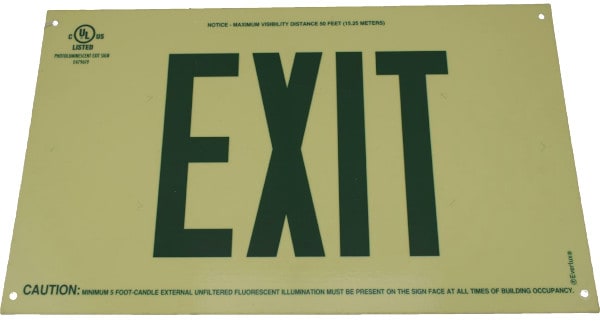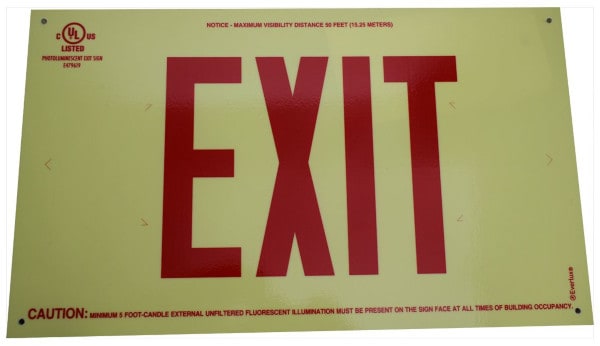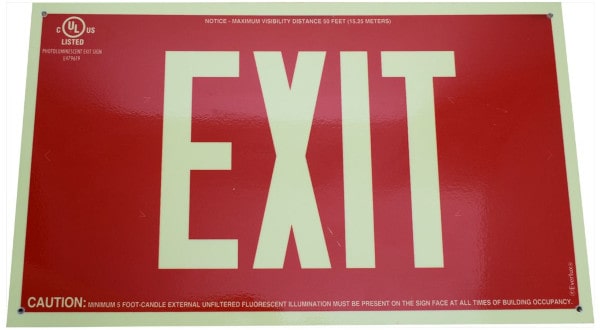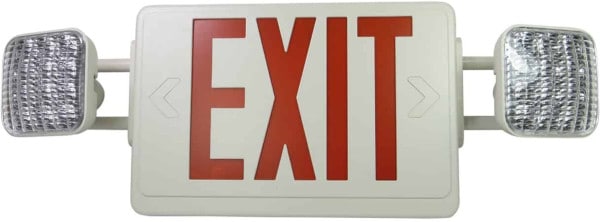Codes don’t favor one type of emergency exit sign over another, but installation and design requirements sometimes do
Tritium and photoluminescent exit signs are listed and tested to the same standards as their electric counterparts. In a sense, all illuminated exit signs really are equal. But a close look at less-obvious factors can help installers and building owners make informed choices that lower lifetime costs, reduce maintenance requirements, and keep signs in compliance with local laws.
We dig into these issues in the text that follows—but for busy readers, here’s our hard-and-fast summary:
- All exit signs, photoluminescent or not, meet the same rigorous standards. No sign type is, strictly speaking, worse than another.
- Photoluminescent signs can be installed, moved, and disposed of easily. The same can’t always be said for electric or tritium signs.
- Most jurisdictions don’t require a certain color for signs’ letters and symbols. If they do, non-photoluminescent signs may be your best bet.
- Non-electric signs can reduce facility managers’ inspection, testing, and maintenance (ITM) burden.
- Electric emergency exit signs can be combined with emergency lighting to reduce the overall number of fixtures required.
Take a look at our combination LED light and exit sign or browse our selection of photoluminescent exit signs, including:
- Everlux’s green-on-photoluminescent-white exit sign (16” x 9”)
- Everlux’s red-on-photoluminescent-white exit sign (16” x 9”)
- Everlux’s red-backed exit sign with photoluminescent white lettering (16” x 9”)
What they all have in common
If you’re looking to buy an exit sign—or already have one—chances are that it’s one of three types:
- Electric. These signs are wired to a building’s electrical supply and, in the event of a power failure, are illuminated with backup power. They may feature emergency lights along their top or sides to aid in evacuation efforts.
- Photoluminescent. Light-absorbing materials store particles of light and discharge them as a greenish glow. To form the letters, arrows, and symbols life safety codes require, these signs feature non-illuminated sections that contrast with the glowing material. Most laws require that they be charged with a suitable electric light source to stay fully illuminated whenever the building is occupied.
- Radioluminescent. Tritium, a type of radioactive gas, interacts with light-emitting compounds to provide a red or green glow. These signs require neither electricity nor UV rays—but they often have additional upfront and disposal costs.

The rules surrounding these exit signs are embedded in building and life safety codes. Most American states and cities base their laws on one of two leading standards:
- The International Building Code (IBC), produced by the International Code Council (ICC)
- NFPA 101: Life Safety Code, developed by the National Fire Protection Association (NFPA)
Both standards have remarkably similar rules for exit signs—and chances are that your jurisdiction relies, in part or whole, on the IBC. Still, it’s important to review your local laws (or consult with local code authorities) before making a decision.
Do life safety codes require specific types of emergency exit signs?
Neither NFPA 101 nor the IBC require electric exit signs. Similarly, neither code requires photoluminescent or tritium exit signs. However, related sign types—particularly the door- and wall-mounted egress signs that fill in the gaps between—may need to glow without electricity. Installers can choose whatever’s most cost-effective, convenient, and safe. But all new internally illuminated exit signs—including most electric, radioluminescent, and photoluminescent types—must be listed in accordance with UL 924 (7.10.6.1.2). These listed models are marked with the UL symbol, as shown below. For more, see section 7.10.6 of NFPA 101 or section 1013.5 in the IBC (2018 editions).

Photoluminescent exit signs may not comply with some local regulations requiring colored lettering
NFPA and the Occupational Safety and Health Administration (OSHA) don’t require a specific color for exit signs, so long as the choice of color doesn’t interfere with visibility. Nor does the IBC. And the two most common colors—red and green—are already featured on most signs.
However, some locales explicitly require either red or green. For example, the municipal code of Chicago, Illinois requires that emergency exit signs’ letters and arrows be red and placed against “a white translucent field.” It’s particularly important to pay attention to these requirements with photoluminescent signs, because:
- The light-absorbing sections tend to glow in white or green hues, even if the sign features red or green components.
- The sign may be a positive-image type (where the letters and symbols glow) or a negative-image type (where the background glows)—meaning that, in some cases, the letters and arrows don’t glow at all.
While model codes grant contractors the discretion to choose sign colors, local codes may not. Check with your authority having jurisdiction (AHJ)—often, but not always, the fire marshal—before purchasing.
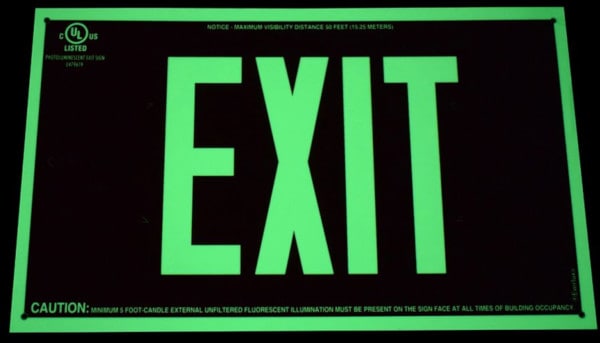
Mounting and replacement may be easiest with photoluminescent signs
Photoluminescent exit signs typically consist of aluminum or plastic, and those lightweight materials make surface mounting easy. A few screws or some adhesive tape are all it takes to secure one to a wall or door. While that means that photoluminescent signs can be easily moved, it doesn’t mean that they should be. Every sign must be placed near a light source with the right characteristics.
Bulbs vary in brightness and color, and mismatches between signs and charging lights may diminish the intensity or duration of the glow. Ultimately, there’s no one-size-fits-all approach: to find out which kinds will work, read your manufacturer’s datasheets.
Electric signs, on the other hand, aren’t always as easy to install. They may be connected to a building’s emergency lighting system or wired to rely on an internal battery backup when power fails. Fastening the sign to a wall may require taking the sign apart—at least in part—to access wires and mounting holes. And removing or replacing one requires special care and electrical expertise that facility managers often lack. However, electric signs can sometimes reduce the total number of fixtures needed. NFPA 101 and the IBC typically call for exit signs and emergency lighting in the same building. That demand can be easily met with devices that combine the two, such as the Simkar-brand combination sign shown below.

Tritium signs fall somewhere in the middle: while they’re wireless (and therefore easier to remove), they can come with substantial repair and disposal costs. A broken sign generally doesn’t pose any immediate threat to those living or working nearby—but all damaged signs should be handled carefully, and contamination from a severely damaged sign can require professional cleanup. In many jurisdictions, tritium signs must be returned to the manufacturer or taken to a facility licensed in the disposal of radioactive materials when it’s time to throw them away.
Photoluminescent and tritium signs reduce the inspection, testing, and maintenance burden
As we’ve explained, listed emergency exit signs—whether photoluminescent, radioluminescent (tritium), or electric—must continue to work during a power outage. Facility managers are tasked with inspecting every sign at regular intervals:
From the 2018 edition of NFPA 101
7.10.9 Testing and Maintenance.
7.10.9.1 Inspection. Exit signs shall be visually inspected for operation of the illumination sources at intervals not to exceed 30 days or shall be periodically monitored in accordance with 7.9.3.1.3.
Section 7.9.3.1.3 allows some tests of electric signs to be conducted automatically with the aid of computers and self-testing, self-diagnostic equipment. Otherwise, facility managers must conduct 30-second tests of each electric device, typically by pressing a “push-to-test” button along the sign’s side. NFPA 101 also requires 90-minute annual tests for many electric signs, as we’ve described in our article on exit sign failure. But building owners with tritium and photoluminescent exit signs appear to have fewer—and shorter—inspection requirements. A monthly visual inspection for each device is enough.
Take a look at the current market for illuminated exit signs
Any of the choices we’ve listed are designed to facilitate safe evacuation—even from particularly confusing buildings. Tritium, electric, or photoluminescent exit signs can, in the best cases, all keep a power outage or natural disaster from threatening human life.
For contractors and building owners, the decisive factor is often cost. In that spirit, we invite you to take a look at some of the signs currently sold through QRFS. You can also check out our combination exit sign and light or browse our full selection of photoluminescent exit signs. For questions, reach out to us at 1 (888) 361-6662 or support@qrfs.com.
Shop UL-Listed Emergency Exit Signs
This blog was originally posted at blog.qrfs.com. If this article helped you, check us out at Facebook.com/QuickResponseFireSupply or on Twitter @QuickResponseFS.



